Submitted:
15 October 2023
Posted:
16 October 2023
You are already at the latest version
Abstract
Keywords:
1. Introduction: The NUSES space mission
2. The need for a Low Energy Module
3. Geometry and detection concept of the LEM
4. Preliminary test on PIPS sensors.
5. Conclusion
Full NUSES Author List
Author Contributions
Funding
Institutional Review Board Statement
Informed Consent Statement
Conflicts of Interest
Abbreviations
| ACD | Anti-coincidence detector |
| CSA | Charge sensitive amplifier |
| FOV | Field Of View |
| GDML | Geometry Description Markup Language |
| GEANT | Geometrty and tracking |
| GRB | Gamma-ray burst |
| IRENE | International Radiation Environment Near Earth |
| LAIM | Lithosphere atmosphere ionosphere magnetosphere |
| LEM | Low-energy module |
| LEO | Low earth orbit |
| LYSO | Lutetium–yttrium oxyorthoSilicate |
| MILC | Magnetosphere ionosphere lithosphere coupling |
| MIP | Minimum ionising particle |
| MPV | Most probable value |
| PID | Particle identification |
| PIPS | Passivated implanted planar silicon |
| SAA | South Atlantic Anomaly |
| TGF | Terrestrial gamma-ray flash |
| VAB | Van Allen Belt |
References
- Burmistrov, L. Terzina on board NUSES: a pathfinder for EAS Cherenkov Light Detection from space. arXiv 2023, arXiv:2304.11992. [Google Scholar]
- Aloisio, R.; Burmistrov, L.; Di Giovanni, A.; Heller, M.; Montaruli, T.; Trimarelli, C. The Terzina instrument onboard the NUSES space mission. arXiv preprint 2023, arXiv:2308.15342. [Google Scholar]
- De Mitri, I.; Di Santo, M.; collaboration, N.; others. The NUSES space mission. Journal of Physics: Conference Series. IOP Publishing, 2023, Vol. 2429, p. 012007.
- Di Giovanni, A.; Di Santo, M. The NUSES space mission 2022.
- Di Santo, M.; Di Giovanni, A. The NUSES space mission 2022.
- Mazziotta, M.N.; Altomare, C.; Bissaldi, E.; De Gaetano, S.; De Robertis, G.; Dipinto, P.; Di Venere, L.; Franco, M.; Fusco, P.; Gargano, F.; et al. A light tracker based on scintillating fibers with SiPM readout. Nuclear Instruments and Methods in Physics Research Section A: Accelerators, Spectrometers, Detectors and Associated Equipment 2022, 1039, 167040. [Google Scholar]
- Mazziotta, M.N.; Pillera, R. The light tracker based on scintillating fibers with SiPM readout of the Zire instrument on board the NUSES space mission. Proceedings of 38th International Cosmic Ray Conference — PoS(ICRC2023) 2023.
- Olinto, A.V.; Krizmanic, J.; Adams, J.; Aloisio, R.; Anchordoqui, L.; Anzalone, A.; Bagheri, M.; Barghini, D.; Battisti, M.; Bergman, D.; et al. The POEMMA (probe of extreme multi-messenger astrophysics) observatory. Journal of Cosmology and Astroparticle Physics 2021, 2021, 007. [Google Scholar]
- Olinto, A.V.; Adams, J.H.; Aloisio, R.; Anchordoqui, L.A.; Bergman, D.R.; Bertaina, M.E.; Bertone, P.; Bustamante, M.; Christl, M.J.; Csorna, S.E.; et al. POEMMA: probe of extreme multi-messenger astrophysics. arXiv 2017, arXiv:1708.07599. [Google Scholar]
- Denton, P.B.; Kini, Y. Ultrahigh-energy tau neutrino cross sections with GRAND and POEMMA. Physical Review D 2020, 102, 123019. [Google Scholar]
- Krizmanic, J. POEMMA: Probe of extreme multi-messenger astrophysics. EPJ Web of Conferences. EDP Sciences, 2019, Vol. 210, p. 06008.
- Kahler, S. Solar flares and coronal mass ejections. Annual review of astronomy and astrophysics 1992, 30, 113–141. [Google Scholar]
- Fishman, G.J.; Meegan, C.A. Gamma-ray bursts. Annual Review of Astronomy and Astrophysics 1995, 33, 415–458. [Google Scholar]
- Piran, T. The physics of gamma-ray bursts. Reviews of Modern Physics 2005, 76, 1143. [Google Scholar]
- D’Angelo, G.; Piersanti, M.; Battiston, R.; Bertello, I.; Carbone, V.; Cicone, A.; Diego, P.; Papini, E.; Parmentier, A.; Picozza, P.; et al. Haiti Earthquake (Mw 7.2): Magnetospheric–Ionospheric–Lithospheric Coupling during and after the Main Shock on 14 August 2021. Remote Sensing 2022, 14, 5340. [Google Scholar]
- Battiston, R.; Vitale, V. First evidence for correlations between electron fluxes measured by NOAA-POES satellites and large seismic events. Nuclear Physics B-Proceedings Supplements 2013, 243, 249–257. [Google Scholar]
- Li, X.; Xu, Y.; An, Z.; Liang, X.; Wang, P.; Zhao, X.; Wang, H.; Lu, H.; Ma, Y.; Shen, X.; et al. The high-energy particle package onboard CSES. Radiation Detection Technology and Methods 2019, 3, 1–11. [Google Scholar]
- Scarduelli, V.; Gasques, L.; Chamon, L.; Lépine-Szily, A. A method to optimize mass discrimination of particles identified in ΔE-E silicon surface barrier detector systems. The European Physical Journal A 2020, 56, 1–7. [Google Scholar]
- Evensen, L.; Westgaard, T.; Avdeichikov, V.; Carlen, L.; Jakobsson, B.; Murin, Y.; Martensson, J.; Oskarsson, A.; Siwek, A.; Whitlow, H.; et al. Thin detectors for the CHICSi/spl Delta/EE telescope. IEEE Transactions on Nuclear Science 1997, 44, 629–634. [Google Scholar]
- Carboni, S.; Barlini, S.; Bardelli, L.; Le Neindre, N.; Bini, M.; Borderie, B.; Bougault, R.; Casini, G.; Edelbruck, P.; Olmi, A.; et al. Particle identification using the ΔE–E technique and pulse shape discrimination with the silicon detectors of the FAZIA project. Nuclear Instruments and Methods in Physics Research Section A: Accelerators, Spectrometers, Detectors and Associated Equipment 2012, 664, 251–263. [Google Scholar]
- Alonso, M.F.; Mitri, I.D. The Zire experiment on board the NUSES space mission. Proceedings of 38th International Cosmic Ray Conference — PoS(ICRC2023) 2023.
- Agostinelli, S.; Allison, J.; Amako, K.a.; Apostolakis, J.; Araujo, H.; Arce, P.; Asai, M.; Axen, D.; Banerjee, S.; Barrand, G.; et al. GEANT4—a simulation toolkit. Nuclear instruments and methods in physics research section A: Accelerators, Spectrometers, Detectors and Associated Equipment 2003, 506, 250–303. [Google Scholar]
- Chytracek, R.; McCormick, J.; Pokorski, W.; Santin, G. Geometry description markup language for physics simulation and analysis applications. IEEE Transactions on Nuclear Science 2006, 53, 2892–2896. [Google Scholar]
- Sloan, K.; Hindi, M.; luzpaz.; lambdam94.; Lei, Z.; JakubDmochowski. KeithSloan/GDML: New Release for FreeCAD 0.20, 2022. [CrossRef]
- Sullivan, J. Geometric factor and directional response of single and multi-element particle telescopes. Nuclear Instruments and methods 1971, 95, 5–11. [Google Scholar]
- PI, G.G.; Guild, S.H.T.; Su, Y.J.; Roth, C.; Charron, J.; Quinn, R.; Starks, M.; Whelan, P.; Friedel, R.; Lindstrom, C.; others. The IRENE (International Radiation Environment Near Earth):(AE9/AP9/SPM) model was developed by the Air Force Research Laboratory in partnership with MIT Lincoln Laboratory, Aerospace Corporation, Atmospheric and Environmental Research, Incorporated, Los Alamos National Laboratory and Boston College Institute for Scientific Research. IRENE (AE9/AP9/SPM) development team: Wm. Robert Johnston1 (PI), T. Paul O’Brien2 (PI).
- ORTEC/AMETEK. Si Charged Particle Radiation Detectors for Research Applications. https://www.ortec-online.com/products/radiation-detectors/silicon-charged-particle-radiation-detectors/si-charged-particle-radiation-detectors-for-research-applications.
- Technologies, M. PIPS detectors. https://www.mirion.com/products/technologies/spectroscopy-scientific-analysis/research-education-and-industrial-solutions/.
| 1 | The estimation of the geometric factor was carried out assuming the definitions and methods described in [25]. |
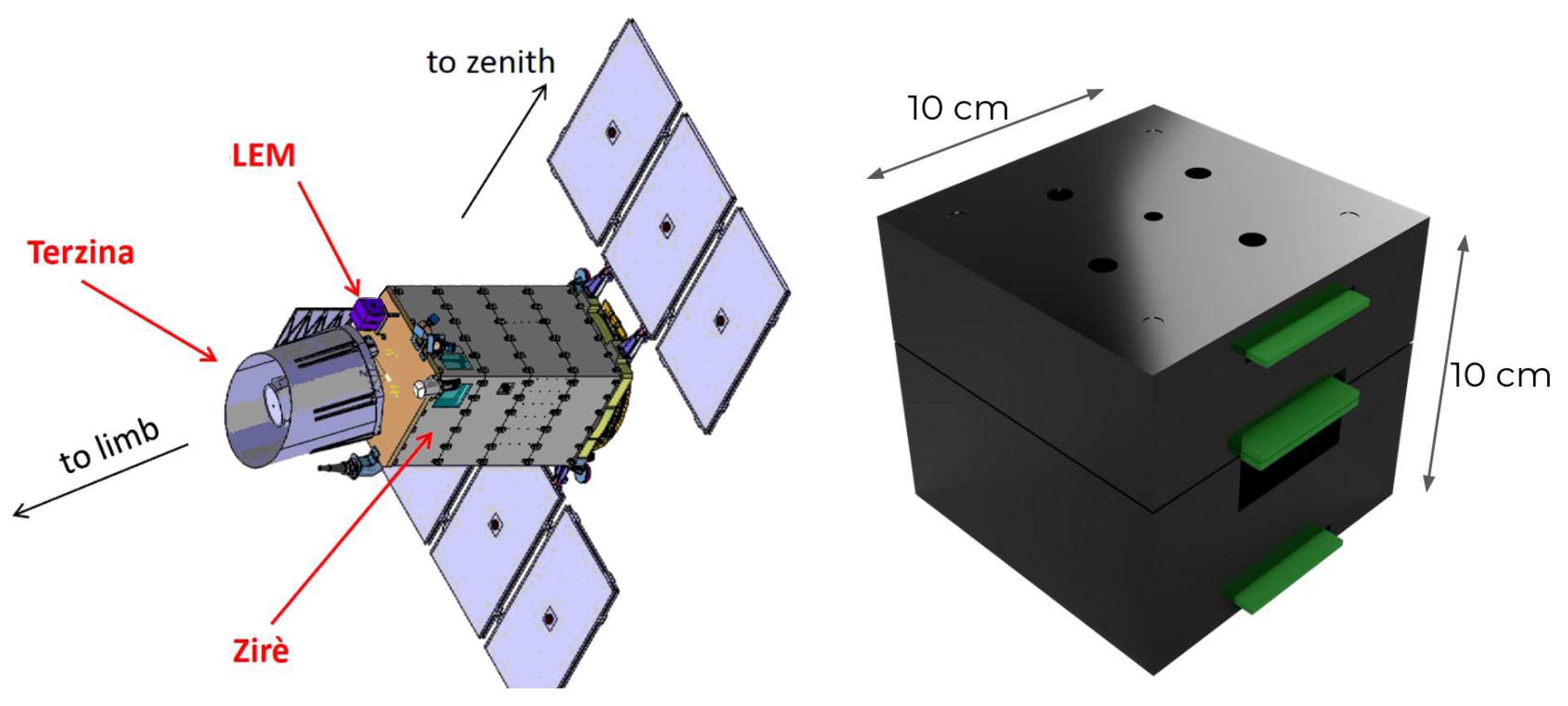
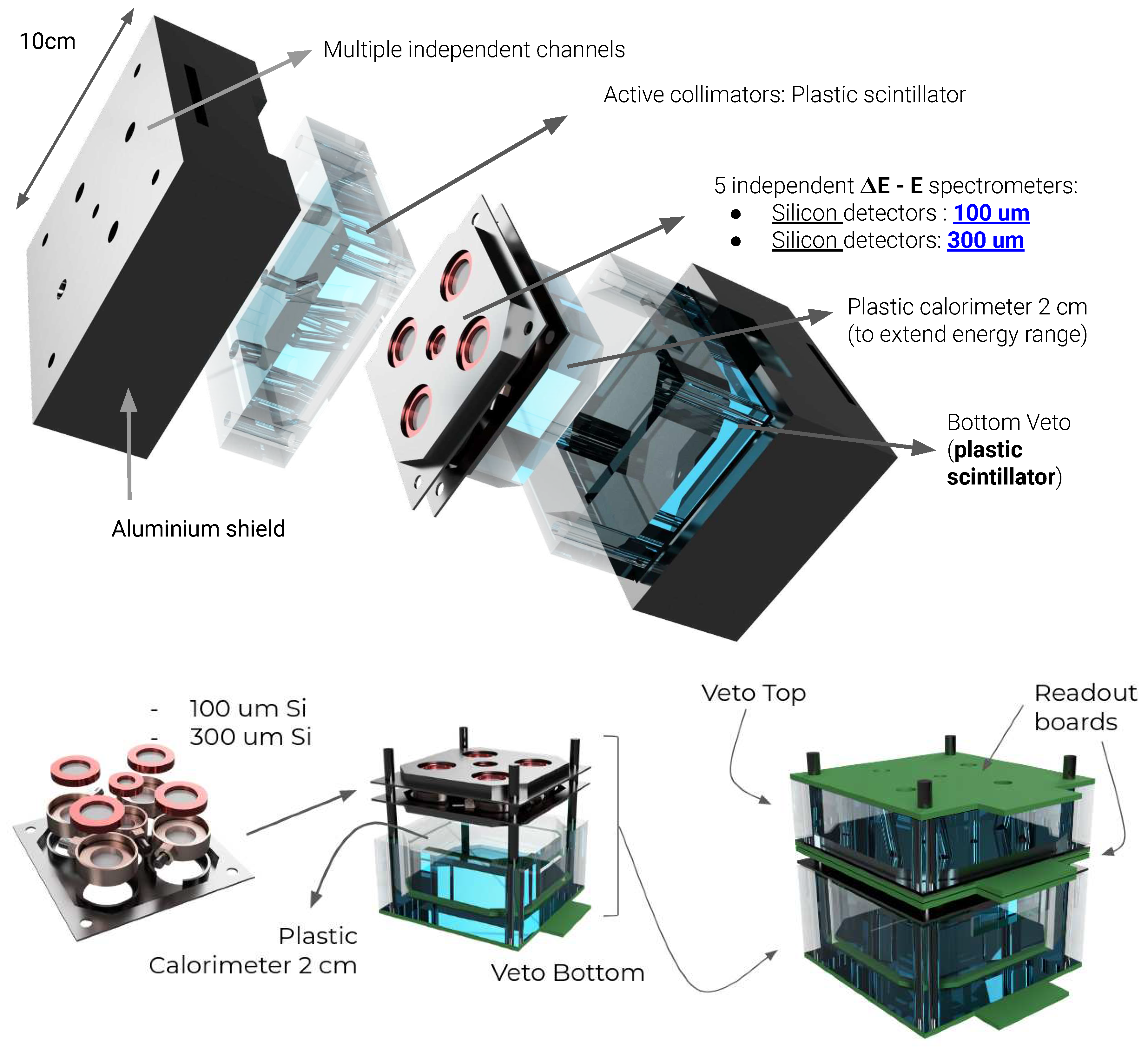
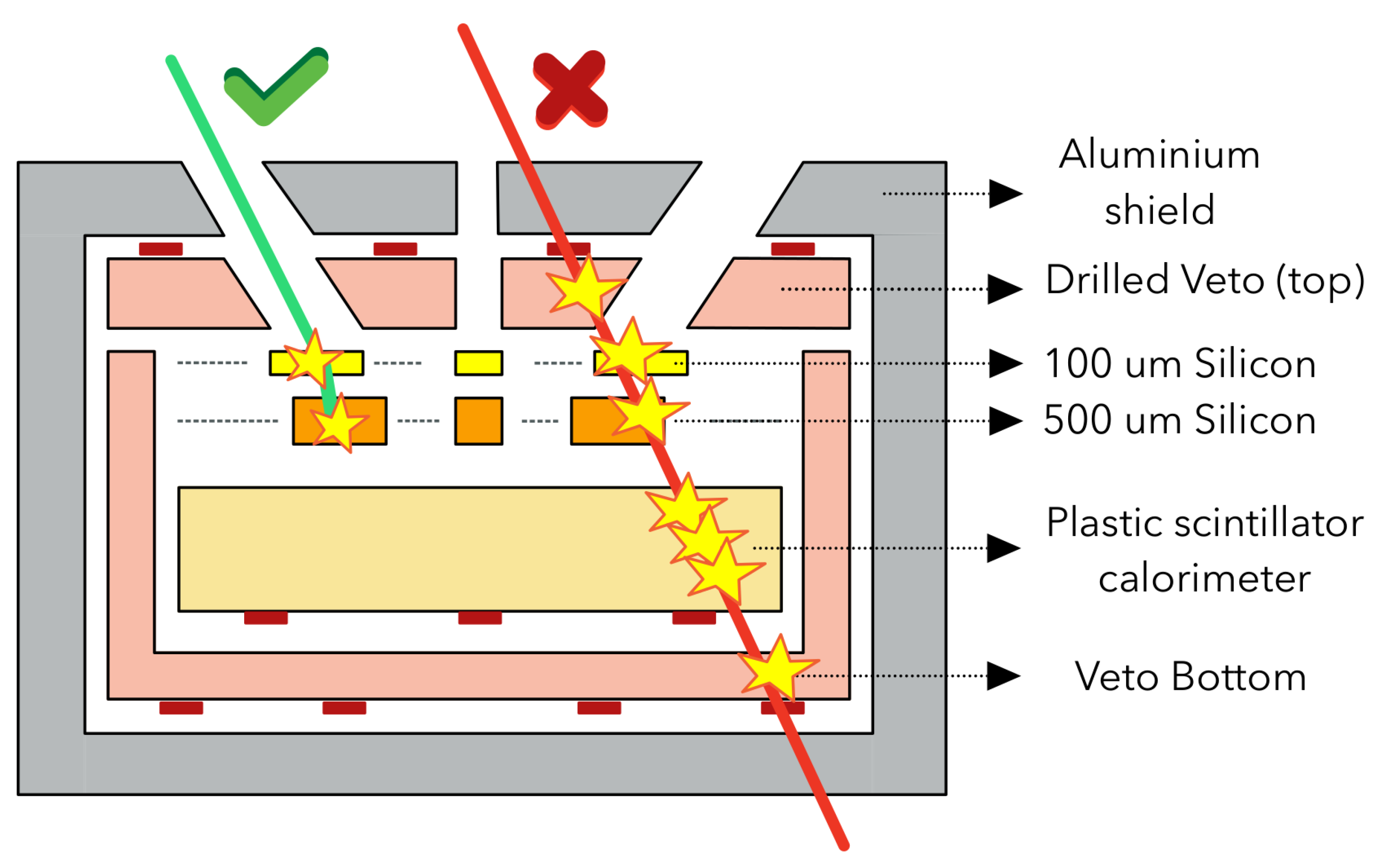
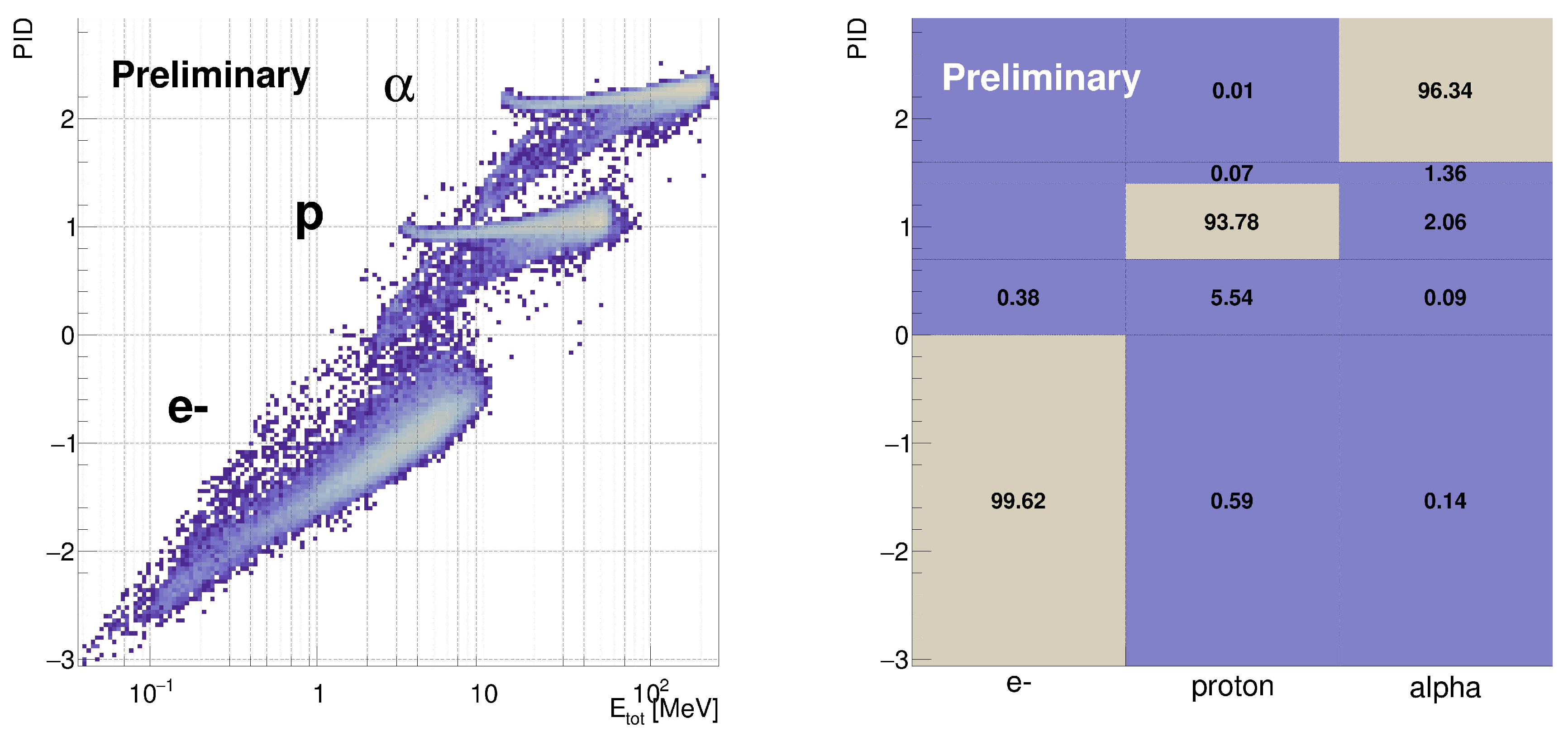
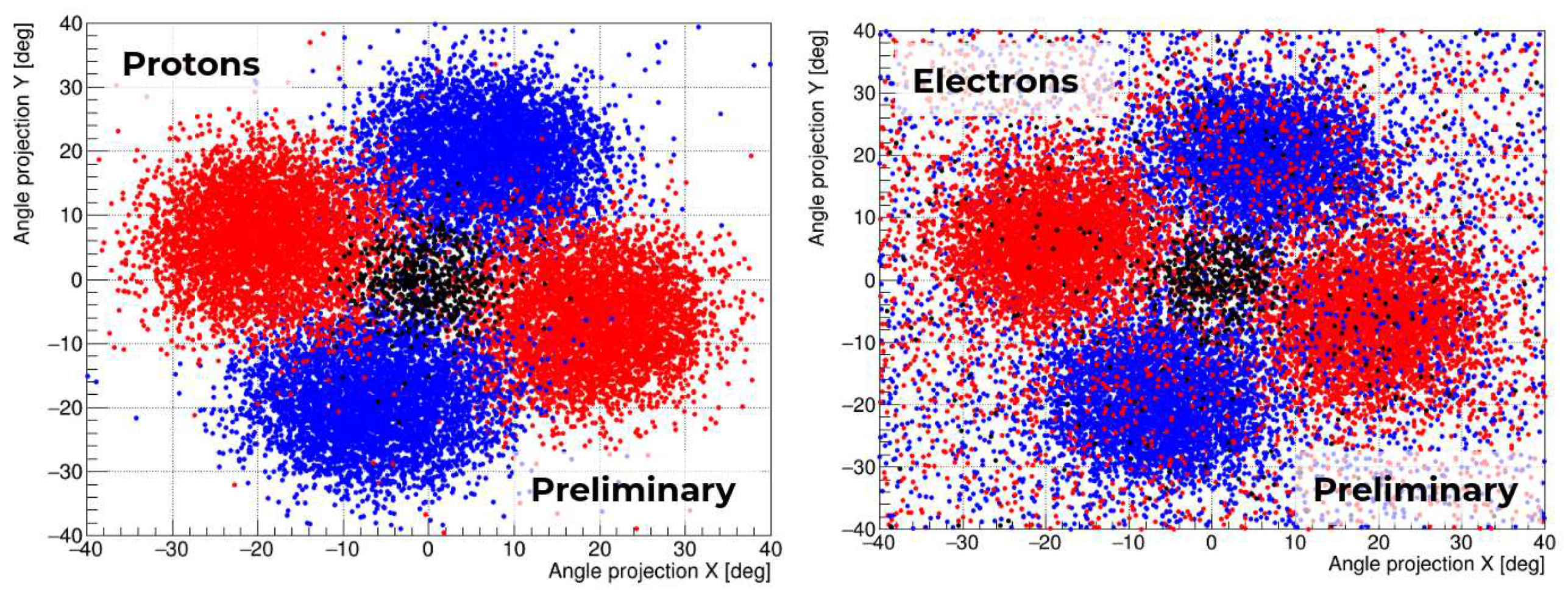
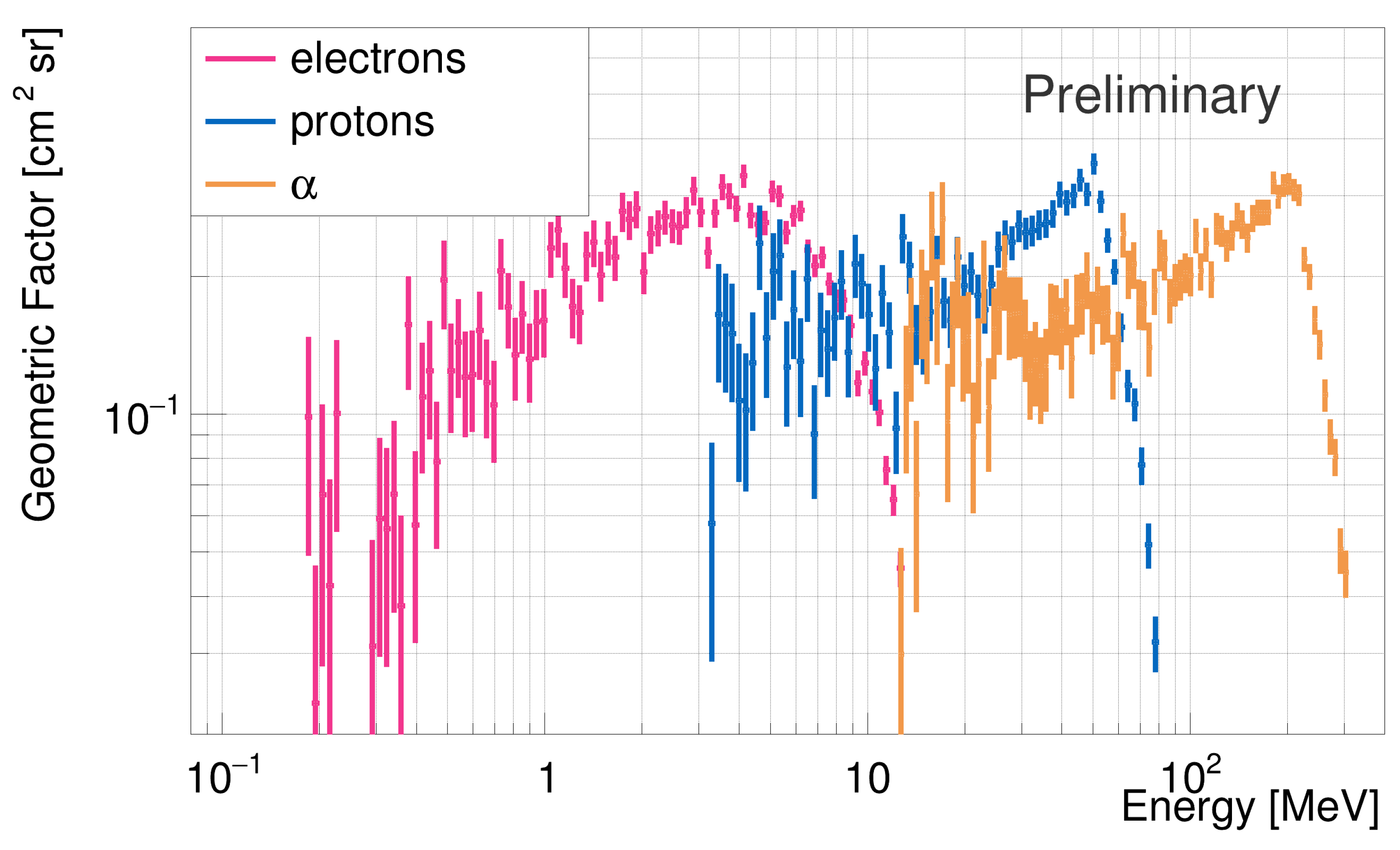
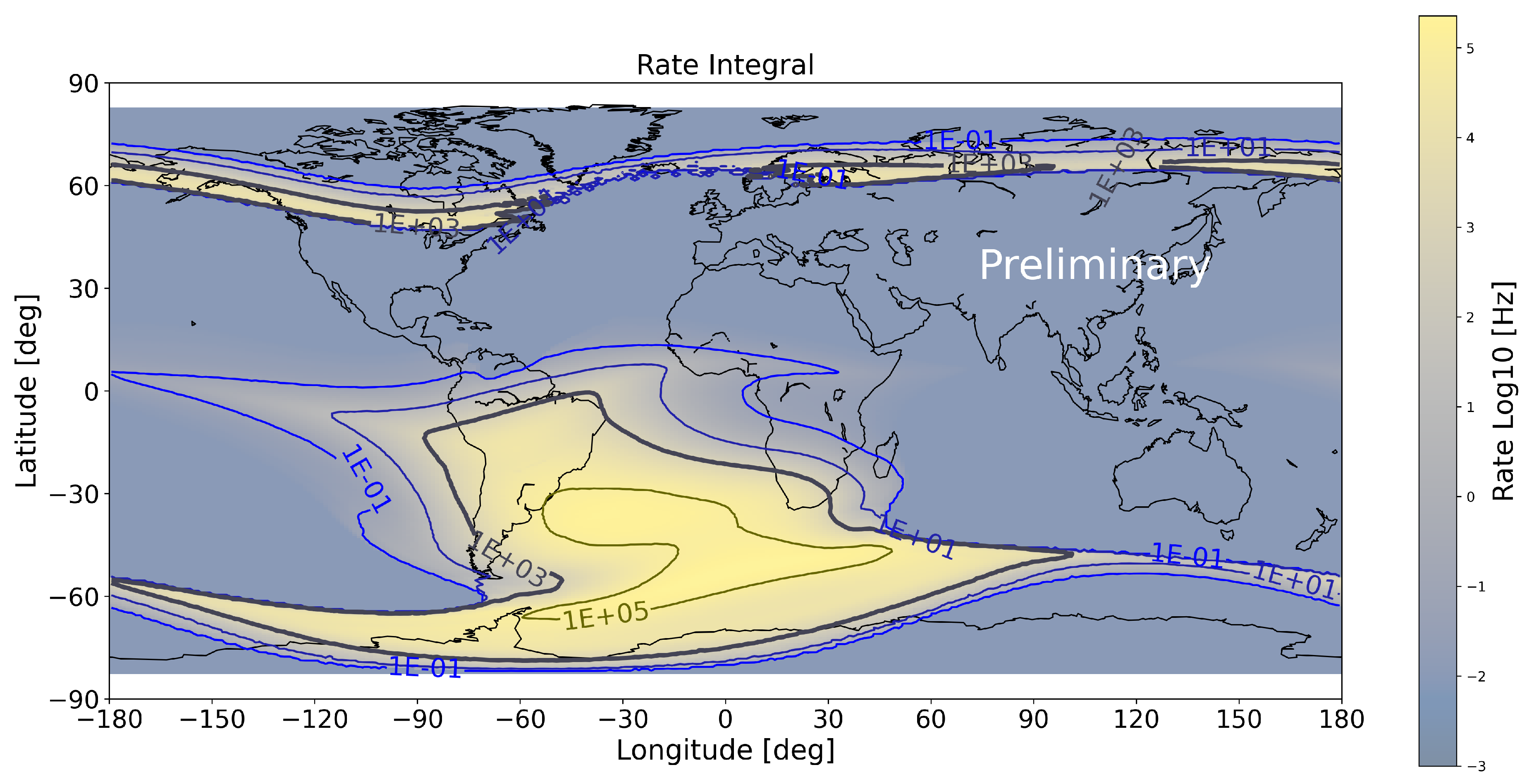
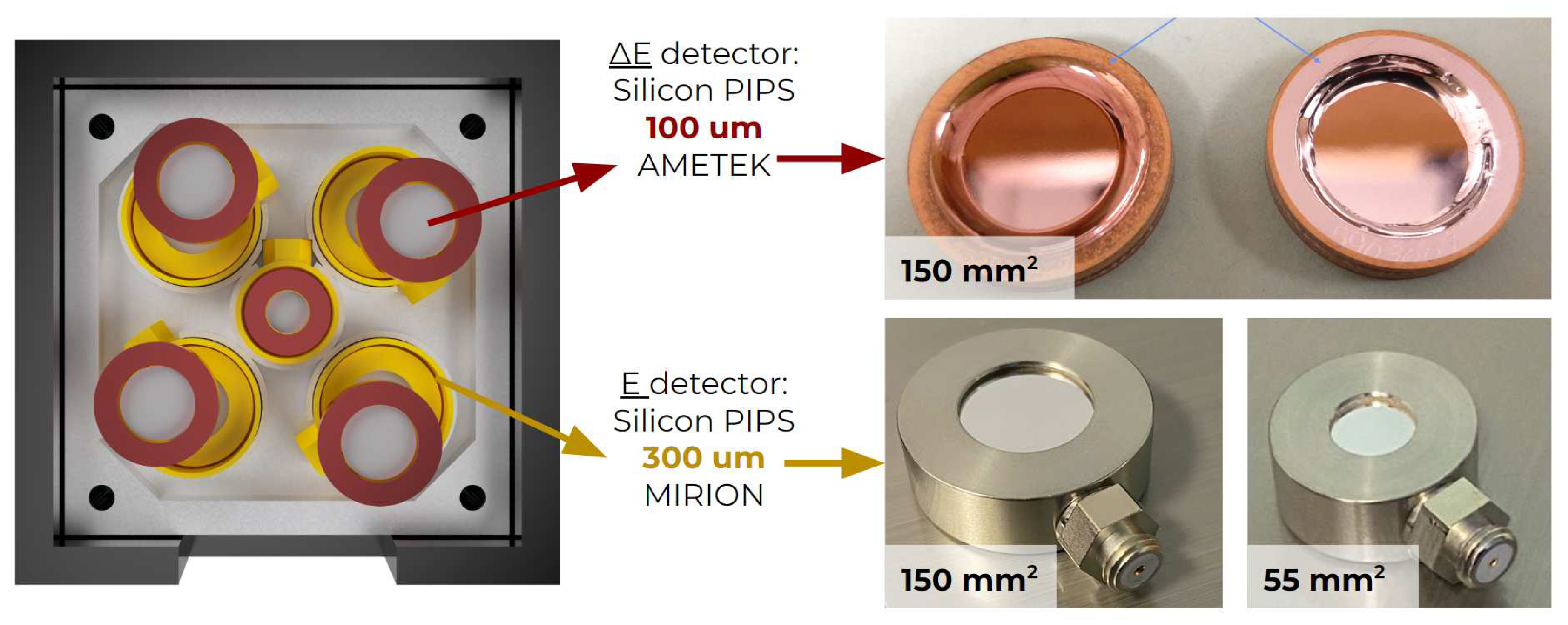
Disclaimer/Publisher’s Note: The statements, opinions and data contained in all publications are solely those of the individual author(s) and contributor(s) and not of MDPI and/or the editor(s). MDPI and/or the editor(s) disclaim responsibility for any injury to people or property resulting from any ideas, methods, instructions or products referred to in the content. |
© 2023 by the authors. Licensee MDPI, Basel, Switzerland. This article is an open access article distributed under the terms and conditions of the Creative Commons Attribution (CC BY) license (http://creativecommons.org/licenses/by/4.0/).




